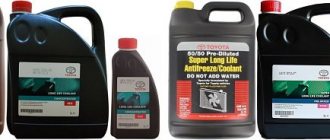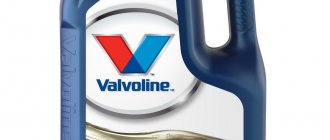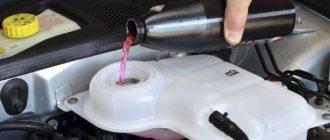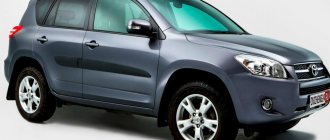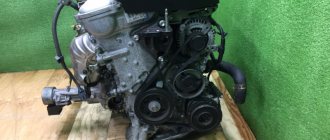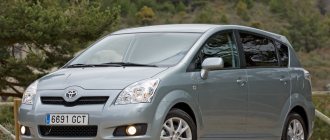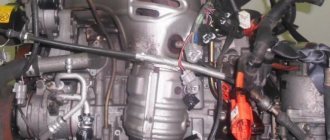All Toyota car owners sooner or later face the issue of choosing a coolant. The modern market offers many effective and high-quality solutions to these problems, but not every driver can make the right choice.
The best option in such cases is Toyota antifreeze, because the automaker knows exactly what its brainchild needs and offers only the best.
Freezing point of concentrate
Many car enthusiasts are accustomed to buying antifreeze in 1 liter cans. And immediately after purchase, they pour the product into the cooling system of their car. But remember that this is not ready-made antifreeze, but a concentrate.
And there is no need to do this, since pure antifreeze has a freezing point of -13, no matter how trite it may sound. At the same time, on the packaging you will always see a freezing temperature of up to -70C, but it only works after mixing with distilled water, or just tap water, depending on the quality of the antifreeze.
As an example, let's take diesel antigel, which freezes in its pure form at temperatures down to -1C, and when mixed with diesel. fuel prevents it from thickening to -33C.
This is interesting: How many liters of oil are in a Ford Focus 2 engine
Choosing antifreeze for Corolla 150
The cooling system of the first Toyota Corolla 150 was filled with proprietary Long Life Coolant (LLC) antifreeze. Its article number is 0888980015, and the cost is 600-900 rubles. The coolant is red in color and is sold in concentrated form. It should be diluted with deionized water in a ratio of 50:50 or 40:60.
The use of distilled water to dilute the concentrate is prohibited. Many car owners note that with this mixing, sediment precipitates and flakes form. All this can lead to clogging of the cooling system circuit and cause the engine to overheat. For dilution, it is recommended to use Ravenol destilliertes Wasser with article number 4014835300514.
Most Toyota Corolla 150 vehicles use pink Super Long Life Coolant (SLLC) part number 0888980140. It is sold ready to fill. At the same time, official dealers recommend converting cars from LLC to SLLC, having first flushed the cooling circuit. The cost of pink liquid ranges from 800 to 3000 rubles.
Despite the fact that the manufacturer prohibits diluting SLLC antifreeze with water, many car owners claim that the coolant should still be diluted with water in a 50:50 ratio before filling. In this case, it is necessary to use exclusively deionized water, for example, Ravenol destilliertes Wasser.
It is prohibited to add distilled water or other antifreeze to Toyota Super Long Life Coolant. In most cases, this leads to the appearance of sediment and flakes, which significantly impair heat dissipation. However, do not mix original red and pink coolants. They are completely incompatible and undergo a violent chemical reaction.
At the same time, the automaker allows the use of antifreeze from third-party companies. Before filling them, the system must be thoroughly flushed. The best options for the Corolla 150 are shown in the table below.
Table - Antifreeze for Corolla 150 from third-party manufacturers
Features of concentrated antifreeze
Antifreeze should not be diluted with tap water, as it contains various impurities that can clog the engine.
The main component of antifreeze is ethylene glycol. Concentrates consist of 95–97% of this substance!, the remaining 3–5%! is distilled water and additives. This product cannot be used in its pure form.
The freezing point of a liquid depends precisely on the amount of ethylene glycol in the composition. It would be logical to assume that the higher the concentration, the lower the temperature, but this is not true. The minimum freezing point of a liquid is -68 C° and is reached when the antifreeze contains 66% ethylene glycol. If the composition is more concentrated, the freezing point increases. Thus, 95%! of the concentrate freezes already at -27 C°, and 97%! – at -22 C°.
Using undiluted product is not advisable, since the air is cooled to -68 C° only in some areas of the Arctic, and therefore, in order to save money, antifreeze can be diluted with distilled water.
What are the differences between antifreeze in appearance?
In order to distinguish antifreeze from plain water or to see the location of a leak in the cooling system, manufacturers add a dye. But, various other components are also added to them, which give other properties to the liquid. And in order to distinguish what properties the components will provide, they are painted in different colors. Coolers of European or Japanese brands are often used.
According to European standardization, G11 antifreeze is colored green
. Components such as inorganic additives, which are included in this composition, provide operation for a period of three years and are used for all types of radiators.
Antifreeze such as G12 is red in color (or from pink to burgundy). The additives in this solution act selectively because they are of the carboxylate type. Therefore, this liquid will cover with a protective layer only the surface that is affected by corrosion. With such a concentrate, the service life will be 5 years.
G13 antifreeze is painted yellow (possibly a brighter shade of yellow). Since it is propylene glycol, the price is an order of magnitude higher because it is more environmentally friendly. It is used for sports or forced engines of passenger cars or various motorcycles.
It is common to use green coolant. Such a cooler freezes at a temperature of minus 25. If the temperature is minus 25, then you need to use green. For those countries where the temperature is about 30 degrees, you need to pour red concentrate into the engine tank.
Properties and characteristics of the solution
The main purpose of antifreeze is to cool the unit. The temperature from the combustion of hydrocarbon fuel exceeds 2,100 °C. Therefore, the power unit requires intensive cooling to prevent premature failure of its parts.
When operating in winter, it is necessary that the coolant does not crystallize. When frozen, it can damage and destroy rubber and plastic parts.
The main components of antifreeze liquids are:
It’s up to you to decide whether to use Castrol or Total. The main thing is that the composition is suitable for your engine. Be sure to take this into account.
The choice of fluid for the cooling system is made based on the operating conditions and recommendations of the manufacturer of the engine, and not the coolant.
Release form and articles
- 08889-80015 Toyota Long Life Coolant RED (LLC)(concentrate) (plastic bottle) 1 l;
- 08889-80015EE Toyota Long Life Coolant RED (LLC)(concentrate) (plastic bottle) 1 l;
- 08889-80032 Toyota Long Life Coolant RED (LLC)(concentrate) (canister) 4 l;
- 08889-80014 Toyota Long Life Coolant RED (LLC)(concentrate) (canister) 5 l;
- 08889-80014EE Toyota Long Life Coolant RED (LLC)(concentrate) (canister) 5 l;
- 08889-80017 Toyota Long Life Coolant RED (LLC)(concentrate) (barrel) 60 l.
Long Life Coolant Toyota – is replacement possible?
This antifreeze is not an inexpensive alternative: it was simply replaced in 2002 by LLC with the Super prefix. Until this time, Toyota engines were filled with “ordinary” Long Life Coolant in red color. Despite the same base and similar additive package, the liquids are incompatible with each other. However, switching from red antifreeze to pink is possible, but only after flushing the system.
The quality of antifreeze is similar: the new generation has become a little more environmentally friendly and retains factory settings longer. Feedback from drivers who made the transition to the new generation of coolers did not reveal any fundamental differences.
Description of original Toyota antifreezes
Toyota antifreeze line
Currently, there are two original Toyota antifreezes:
- Toyota Long Life Coolant;
- Toyota Super Long Life Coolant.
Until 2002, at the factory, Toyota cars were filled with predominantly the first antifreeze - LLC. Since 2002, it was replaced by a second one - Super LLC. Now it is this that is used in most models of this brand.
However, both antifreezes have a lot in common. Each of them is based on the highest quality propylene glycol, as well as powerful corrosion inhibitors and balanced modern additives. But everyone has their own, so mixing these two antifreezes is strictly prohibited. Otherwise, the mixture will be significantly inferior in quality to separately used coolants.
Despite the fact that Toyota cars now primarily use Super Long Life coolant for factory filling, its predecessor should not be written off. Antifreeze Toyota LLC can still be purchased for use in a personal vehicle, on sale and in containers of various sizes.
From a general point of view, it is also worth noting that both refrigerants are produced both as a ready-to-use coolant and as a concentrate. The latter is not suitable for use in its pure form; it must be diluted with water. How to dilute, in what proportion, depends on the climatic conditions in which the coolant is supposed to be used, and the maximum sub-zero temperature in the region. The optimal ratio, suitable even for the northern regions, is considered to be one to one. At the same time, protection will be provided to an average of minus 40 degrees Celsius. The minimum volume of concentrate should be one third of the total volume of liquid, and the maximum should be 70%.
It is best to mix concentrated antifreeze with distilled water, but if this is not available, you can also use tap water. Diluting the concentrate with water from rivers, lakes, and natural wells is strictly prohibited.
Important! If it is not possible to buy antifreeze recommended by the Toyota manufacturer, then analogues with the appropriate base and additive package can be used for replacement. It is better not to mix antifreezes from different manufacturers unless absolutely necessary; this can significantly deteriorate their characteristics and reduce their service life.
Both Toyota antifreezes have undergone numerous tests and tests, according to the results of which it can be stated that they comply with all manufacturer’s statements and international requirements and industry standards. Positive reviews from car enthusiasts confirm this.
Toyota Long Life Coolant
Finished liquid and concentrate LLC
Toyota Long Life Coolant red antifreeze is a traditional propylene glycol-based antifreeze using high-quality additives and corrosion inhibitors. Externally it is a clean, transparent red liquid.
Toyota red antifreeze has good lubricating properties and has a high degree of protection of the cooling system from wear and corrosion. It has good heat dissipation properties and perfectly protects the engine from overheating and hypothermia.
Toyota Long Life Coolant antifreeze is suitable for use in the internal combustion engines of both Toyota trucks and passenger cars. Antifreeze is replaced after three years during the initial fill, and every two years for subsequent fills.
Articles and packaging volumes of LLC antifreeze:
- 08889-80015 – 1 l;
- 08889-80032 – 4 l;
- 08889-80014 – 5 l;
- 08889-80017 – 60 l.
If necessary, you can mix this antifreeze with silicate, hybrid coolants.
Toyota Super Long Life Coolant
Prepared and concentrated liquid SLLC
Toyota Super Long Life coolant antifreeze is a ready-made antifreeze and concentrate produced on the basis of propylene glycol using organic acid (carboxylate) technology using powerful modern corrosion inhibitors. Its chemical composition does not contain silicates, nitrates and other harmful substances that negatively affect engine performance, impair heat transfer, and contribute to the formation of deposits inside the cooling system. They also cause harm to the environment. This means that this antifreeze is not only safe for the engine, but also environmentally friendly.
Externally, Toyota Super Long Life Coolant antifreeze is a transparent, clean liquid of pink color. It complies with the Volkswagen standard G12 or C12+ - for modern carboxylate antifreezes with a long service life. It has a really long lifespan: it will have to be replaced on average every five years.
This coolant is recommended for any modern engines, both Toyota cars and trucks.
Toyota pink antifreeze perfectly prevents the formation of corrosion, cavitation, does not foam, and does not oxidize. Helps maintain normal operating temperature inside the engine and extends its service life.
Articles and packaging volumes of SLLC antifreeze:
- 08889-80070 – 2 l;
- 08889-80071 – 4 l;
- 08889-80072 – 5 l.
Important! Toyota SLLC pink antifreeze is strictly forbidden to mix with others, and also (regarding ready-to-use liquid) cannot be added with water. Otherwise, the substance will coagulate and further operation of the cooling system will be impossible.
What antifreeze to pour into a Toyota engine
The question of replacing antifreeze usually arises after purchasing a used car or after repair work. Of course, a new antifreeze must be selected from the list recommended by the car manufacturer, and it is best to use the same original antifreeze that was filled in at the car plant. Let us remind you that the efficiency and durability of the engine depends on the coolant, so the correct choice of antifreeze is of great importance. TOYOTA has recommended (since approximately 2001) the use of only super long life coolant - Toyota Super Long Life Coolant or similar high quality non-silicate, non-amine, non-nitrite, non-boron coolant based on ethylene glycol using hybrid organic acid technology for long life. .
Toyota Super Long Life Coolant is a mixture containing 50% refrigerant and 50% deionized water.
Freezing temperature, down to approximately -35°C. Do not mix with antifreezes of other manufacturers and other colors. The period for replacing antifreeze
is determined based on the type of antifreeze, the design features of the car and, most importantly, the results of road tests. This period is determined by the car manufacturer, not the antifreeze manufacturer. Antifreeze manufacturers also often indicate the service life on canister labels and in documentation. The primary one, of course, is the replacement period determined by the car manufacturer. Only if the car manufacturer does not give any instructions about the period for replacing antifreeze, you can use the antifreeze manufacturer's recommendation.
ORIGINAL TOYOTA ANTIFREEZE - THERE ARE TWO TYPES
View the availability and cost of antifreeze for the Toyota engine,
can be found in the side menu section of our website
Option No. 1
Super Long Life Coolant (SLLC) - pink antifreeze
The cooling system of a new car is filled with this type of coolant. The advantage of this fluid is the extended replacement interval, which is performed first at 160,000 km / 5 years, then every 80,000 km.
If TOYOTA SLLC (pink) antifreeze is mixed with TOYOTA LLC (red), the LLC service interval must be every 40,000 km (24,000 miles) or 24 months, whichever comes first.
V A R I A N T No. 2
Long Life Coolant (LLC) coolant concentrate - red,
in this case replacement is carried out every 40,000 km / 2 years.
Each car company independently determines which antifreezes should be used in which models of their cars.
Unfortunately, there is no universal antifreeze suitable for all types of cars. To avoid problems associated with low-quality antifreeze, and not to be hostage to unfair advertising, use only antifreezes that are approved by the car manufacturer. All modern automotive coolants (antifreeze) consist of ethylene glycol, water and additives. The base components, water and ethylene glycol, make up approximately 93–97% of the liquid volume, the rest is additives. The additive package determines the properties, service life and cost of antifreeze. It is by additives that antifreezes from different manufacturing companies differ from each other. Based on the composition of additive packages, modern antifreezes are divided into three main types - “carboxylate”
,
“hybrid” and “traditional”. Carboxylate antifreezes
are considered the best, both in their properties and in their long service life; they differ from other antifreezes in the production technology of the additive package, which is based on salts of aliphatic carboxylic acids (carboxylates). Carboxylates are unsurpassed corrosion inhibitors, stable at high temperatures, and withstand long service life. Protecting the cooling system from corrosion, carboxylate antifreezes create a protective layer only in areas of corrosion, covering them with an ultra-thin protective film. This does not impair heat transfer, since a protective layer is not created on the rest of the surface. Thus, carboxylate antifreezes have improved cooling properties. As a result, with such “spot” protection against corrosion, the consumption of additives occurs much more slowly, which increases the service life of the antifreeze.
In the technical literature and in the names of antifreezes, the following terms are used to denote carboxylate technologies: OAT (Organic Acid Technology), LLC (Long Life Coolant)
, ELC or XLC (Extended Life Coolant), SNF (Silicate Nitrite Free), SF (Silicate Free), G12+ (to VW specification TL 774-F)
The fundamental difference between carboxylate technology and other technologies is that it does not contain inorganic additives characteristic of “traditional” antifreezes.
Hybrid antifreezes
are also excellent coolants, with an extended service life.
They were developed in the early 90s, several years earlier than carboxylate antifreezes. Their additive packages also include salts of carboxylic acids in combination with salts of inorganic acids - hence the name “hybrid”. European hybrid antifreezes use silicates along with carboxylates, Japanese and Korean ones use phosphates
, and American ones use nitrites.
In the technical literature, hybrid antifreezes are designated: HOAT (Hybrid Organic Acid Technology), Hybrid Technology, NF (NitriteFree), G11 (according to VW TL 774-C specification).
Traditional antifreezes
are so-called inorganic technologies, which are now largely obsolete. In the technical literature, traditional antifreezes are denoted by the words: Traditional, Conventional, IAT (Inorganic Acid Technology). The additive packages of such antifreezes consist of various combinations of salts of inorganic acids - silicates, phosphates, borates (borax), amines, nitrates, nitrites. Carboxylates are not included in traditional antifreezes. Note. Antifreezes containing benzoates (salts of benzoic acid, which belongs to aromatic carboxylic acids) are also classified as the traditional type. Traditional antifreezes were used in the 60s - 90s, and then were gradually replaced by new, more advanced hybrid and carboxylate antifreezes. Refusal to use traditional antifreeze is associated with the disadvantages of inorganic additives that are included in their composition. Thus, silicates tend to form gels and abrasive particles, which reduce heat removal from the engine, clog the cooling system, and destroy the pump. Phosphates may precipitate when antifreeze is mixed with water. Nitrites oxidize very quickly and require regular replenishment. All these inorganic additives are consumed quite quickly, which is why the service life of traditional antifreeze is relatively short. On average, it is 2–3 years, but each car company sets this period individually. At the same time, studies have shown that in combination with carboxylates, the disadvantages of inorganic additives appear to a lesser extent. Therefore, hybrid antifreezes turned out to be much more effective than traditional ones.
Back to list of articles
What to use for dilution
Everyone decides for themselves whether to use a concentrate or a ready-made composition. The convenience of its use speaks in favor of the second option. Be sure to keep a canister of coolant in your car. Deficiency, contamination and simply loss of your coolant can be one of the reasons for engine overheating. The consequences may be unpredictable, but certainly expensive to eliminate.
The brake pads freeze on the handbrake: what to do, how to prevent it in the future
If you choose a concentrate, be sure to decide on the manufacturer and its type. There are compositions marked G11, G12, G13, the composition can be green or red. In order not to repeat myself, I suggest you read our material on mixing antifreeze, where you will get answers to all your questions. In the meantime, let's talk about an equally significant point, which concerns the preparation of finished cooling liquid based on a concentrated composition. After all, so much has already been said about dilution, but no one has yet answered with what exactly needs to be diluted.
Antifreeze is a liquid that simultaneously prevents the engine from overheating, cooling it, and keeps it clean, protects it from additives, rust, sediment and other types of contaminants, including corrosion.
Some people dilute the concentrate with tap water. This is absolutely wrong, since such water contains chlorine, magnesium, calcium and other components that are dangerous to water. They clog the internal channels of the cooling system, reduce its efficiency, provoke rust formation, etc.
The concentrate can only be diluted with purified distilled water.
The peculiarity of this water is the absence of harmful impurities. Just don't run to the pharmacy for it. Car dealerships sell cans of various sizes for little money. My wife suggests that it is useful to use the same water for irons, as it prevents the formation of scale.
What should you use to dilute the liquid?
There are two types of antifreeze sold in stores: diluted and in the form of a concentrate. The concentrate contains ethylene glycol, which freezes at a temperature of -13, so it is strictly forbidden to fill in undiluted coolant. Remember that antifreeze concentrate can only be diluted with distilled water, otherwise you will have many problems due to which the engine of your car will not receive the necessary protection and will break down.
Do not dilute with tap water, because it may contain various trace elements that, if they get into the cooler, will cause your car’s engine to corrode very quickly or may ruin its operation. There is no need to mix antifreeze concentrate of different brands and different colors
.
If you still decide to change the cooler class from one to another, then you will need to thoroughly rinse the radiator. Dilute the antifreeze concentrate with distilled water in the correct proportions and pour it into the cooling system through the radiator or expansion tank.
Advantages and disadvantages
Toyota Long Life antifreeze provides the following benefits:
- prevents the formation of corrosion inside the cooling system;
- has a very low freezing point;
- has a very high boiling point;
- perfectly removes heat from a running engine, ensures normal operating temperature;
- prevents the formation of deposits inside the cooling system;
- can be used for any cars;
- lubricates parts well, preventing wear.
Consumer reviews are mostly positive. Confirm all declared technical characteristics of the composition. However, now more modern coolants are more popular - carboxylate, hybrid, lobrid. They have higher protective properties and service life.
General characteristics
Toyota produces two original antifreezes:
- Toyota Long Life Coolant;
- Toyota Super Long Life Coolant.
At the factory, until 2002, only the first antifreeze, LLC, was poured into Toyota cars. The second antifreeze, Toyota Super Long Life Coolant, began to be poured after 2002. Today it is used in most cars of the brand.
Both antifreezes have similar properties. Each of them is created on the basis of high-quality propylene glycol in combination with corrosion inhibitors and modern additives. Antifreezes cannot be combined, since their additives are radically different. Otherwise, the resulting mixture will be inferior in its characteristics to other coolants.
Despite the fact that the latest Toyota models use Super Long Life antifreeze, its previous version - long Life - should not be written off. Toyota Long Life antifreeze is still available for sale today and is widely distributed among car owners.
Both types of refrigerant are produced either as a finished coolant or as a concentrate. The latter must be diluted with water before replacement. The specific proportions depend on the climatic conditions of use of Toyota antifreeze and the lowest temperature in the region. For the northern regions, the optimal ratio is one to one. The mixture provides engine protection at temperatures down to -40 degrees. The minimum volume of concentrate should be 30%, the maximum - 70%.
Concentrated antifreeze is diluted with distilled water, but if it is unavailable, tap water can be used. Water from natural sources is not suitable for diluting the concentrate.
As a replacement for Toyota antifreeze, you can use analogues that have the appropriate base and additives. It is better not to mix coolants of different brands, as this can reduce their service life and deteriorate their performance.
Both Toyota antifreeze products have been tested and tested in the company's laboratories, the results of which confirm that they meet all industry and manufacturer standards.
How to spot a fake
Information on the canister labels
It cannot be said that original antifreezes, suitable only for one brand of car, are counterfeited as often as the most popular, universal, branded coolants are often counterfeited. However, this is not completely ruled out. Therefore, the coolant canister must be carefully inspected. Here are some signs that may indicate a fake:
- rough, uneven seams or defects in their area;
- a lid that does not fit tightly to the ring, scratches, chips, and other signs of tampering along its edges;
- unevenly glued labels, bubbles and folds on them, traces of glue;
- information that does not correspond to reality or contains errors;
- blurred text, uneven lines;
- unreadable release and bottling date.
If something in the appearance of the canister is alarming or raises doubts, then it is better to double-check. You should not pour antifreeze into the tank until you are completely sure of its quality.
Percentage ratio when diluting liquid with distilled water
If you need to properly dilute antifreeze concentrate, then you should completely read the instructions, which are usually included with the packaging by manufacturers. In no case do not pour more water than necessary, because then the cooler will lose its properties. Don't forget about the climate conditions in which you live.
The table shows how to dilute antifreeze concentrate:
| Water percentage | Concentrate percentage | Freezing threshold | Boiling threshold |
| 87,5% | 12,5% | -7 | 100 |
| 75% | 25% | -15 | 100 |
| 50% | 50% | -40; -45 | +130; +140 |
| 40% | 60% | -50; -60 | +150; +160 |
| 25% | 75% | -70 | +170 |
Don't forget to take care of your car, because in winter it especially needs protection due to the drop in temperature. If you take into account all the recommendations about the method of using coolant and carefully read the label on the package, you will save yourself from constant major repairs of the car.
← Previous material
Next material →
Coolant properties
Antifreeze is used not only for cars, but also for heating systems and aircraft engines. The liquid contains ethylene glycol and various additives
. They will improve not only the operation of the units, but also prevent their rapid wear. If the concentrate is diluted correctly, the coolant will provide the following conditions for the engine:
- the boiling point will be low or optimal;
- the service life will be long and without loss;
- rubber products will get rid of the aggressive influence on them;
- the boiling point will be high and the thermal conductivity will be high;
- anti-foam characteristics will be high.
Read more: Opel astra g bertone
If at least one of these conditions is not met, then your car will be repaired.
Which antifreeze concentrate is better?
Antifreeze concentrate is available in several colors
Different colors of concentrates exist to differentiate product classes, brands and their compatibility.
Coolant is essential for good engine performance. Otherwise the motor may be damaged. The coolant contains reagents that do not freeze. Among other things, antifreeze comes in various colors: green, red, blue, etc. The colors are obtained due to the non-food dyes present in the liquid. Different colors exist to differentiate product classes and their brands. And also their compatibility. Remember what color you filled in , and next time take the appropriate color. Color compatibility is indicated on the label. Antifreeze concentrate is green . In addition to the dye, its composition includes a fairly large number of various additives. They prevent corrosion and destruction of engine and radiator surfaces. Allows the entire system to operate better at different temperatures and in different climatic zones. Typically, the freezing point of antifreeze concentrate can be from -40 to +50 degrees. But each manufacturer may have its own nuances. Antifreeze concentrate is red . Before use, dilution should be done with distilled water. If the manufacturer assures that it can be diluted with tap water, then it is better to make a little mixture for testing. In a few days it will be clear whether precipitation has fallen or not. Various additives added to this coolant help improve the performance of the cooling system. For a temperature of -40°C, the concentrate must be diluted in a ratio of 1:1. At t -30°C in a ratio of 2:3, at t -20°C in a ratio of 1:2. Antifreeze concentrate blue . It has excellent anti-corrosion properties and a long service life. This coolant is designed for both diesel and gasoline engines. It should be diluted with distilled water in a ratio of 1:1, which makes it possible to work at a temperature of -35°C. A little advice: to avoid purchasing fakes and counterfeits, it is recommended to buy coolant concentrate in specialized stores. Always pay special attention to the manufacturer's brand. Here are several manufacturing companies that produce high-quality products that contain additives that prevent the formation of steam moisture in the system:
- Lukoil;
- Hepu;
- Febi;
- Sintek, which belongs to the Obninskorgsintez concern;
- Felix;
- AWM.
The price of antifreeze concentrate depends on the manufacturer, the region of sale, the quality and volume. We must remember that quality goods are always more expensive. You should not skimp on quality; in any case, it will not be profitable, since you can lose a lot of money on expensive repairs.
- Antifreeze plays an important role in the operation of essential vehicle systems.
- Incorrect proportions when diluting the refrigerant with water can cause serious damage to parts and disrupt the integrity of the overall operational system of the internal combustion engine.
- To dilute the concentrate, only distilled water is used, since it does not leave suspensions or sediments, which over time can cause blocking of engine parts and working units.
